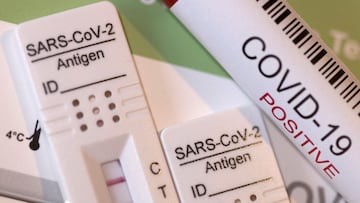What do covid rapid home tests measure and what does a faint line mean?
Rapid antigen tests detect an active coronavirus infection in the body. Even if the line is faint the test is considered to have given a positive result.

John Hopkins University covid tracker is currently reporting over 18 million new covid cases in the past 28 days, as the US suffers under the wave of the highly infections omicron variant. Given the current levels of infection more and more Americans are turning to rapid home tests to self-test and confirm their covid status.
Quick covid knowlege with rapid tests
The at-home rapid tests can tell you within minutes whether you have an active covid infection; the problem up to now has been finding one, with stocks short across much of the country. President Biden promised a $1 billion investment in home testing and on the federal website COVIDTests.gov you can request free coronavirus testing kits.
The federal government has purchased 500 million home tests to be mailed to households and have said they plan to double that amount in the near future. Note that if you have insurance you can also buy online or at a store and be reimbursed by your insurance company.
But what do these rapid covid tests actually measure?
These rapid at-home tests, also known as lateral flow tests (because the sample flows laterally along the test pad), are testing for the presence of a protein found on the surface of the coronavirus. That protein is known as an antigen, because it triggers an immune response in the body. The tests are therefore also known as antigen tests.
The tests work much like a pregnancy test, with a pink line indicating that the test has reacted with the antigen. In order to get the sample for the test, you need to pop up a swab up each nostril and give it a good swirl about so it can pick up some material. You then either pop the swab directly into a reader, or dip it into a solution, which is then poured into a test strip. Then sit back and wait 10 to 15 minutes for the result.
Reading the test
On the test you’ll see there are two letters marked, C (Control) and T (Test). Provided the test is done is correctly the C line will appear. If the C line does not appear the test was incorrectly carried out (likely due to insufficient liquid or a mistake in carrying out the test) - even if the T line appears, if the C line does not a new test should be carried out, as the test has failed. If however the C line is merely faint, the test is ok, and can be considered valid.
If the result is positive, the T line will appear, indicating that the test has detected coronavirus antigens. Where that line is faint, the test is still considered to have given a positive result, although experts say it may mean the viral load is low. Even if the viral load is low however you are still likely infected with covid-19 and are likely to be infectious, meaning all precautions applicable should be followed.
There is no requirement in the USA to inform any public agency of a positive at-home test, but you should let your physician know. You can also go to a testing center to get confirmation. The CDC says that if you test positive using a rapid home test you should “isolate” and “inform your health care provider as well as any close contacts”.
Reliability of rapid home tests
Related stories
Where you have an active infection, and are likely to be contagious (i.e. you have a high viral load) the rapid home antigen tests are highly reliable, with the tests giving a positive result in around 98% of cases on the days a person is most infectious. However if you’ve just caught the coronavirus it’s entirely possibly to have a negative test and then test positive a few days later, once the virus has replicated in your body. It’s best to think of the test checking whether you have a lot of virus in your nose, rather than if you have any virus at all in your body.
When should I test?
Doing more tests is good. Taking one single test cannot confirm you don’t have covid. You should take at least two tests over three or four days, with the CDC saying the best testing window is to test three to five days after a high-risk event where you may have been exposed, or where you know you have been in contact with an infected person.

